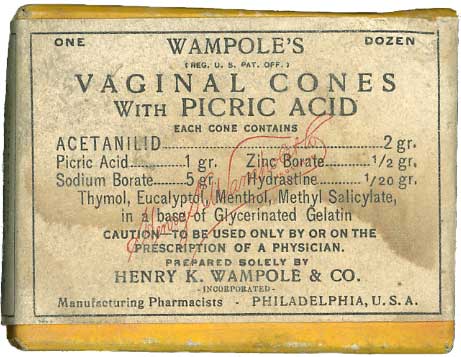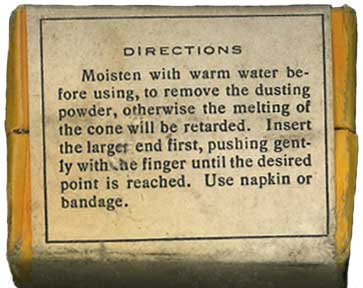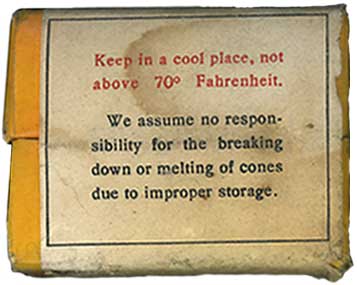|


|

Wampole's Vaginal
Cones with Picric Acid
Small boxes of old American patent medicine
for women's diseases,
headache, stomach illness, menstruation, and
birth control
SarahAnne
Hazlewood generously donated the
medicine to this museum, part of her
huge gift of medical instruments, books
and advertising material about women's
health.
Harry Finley
created the images.
It's hard to imagine why Wampole
put picric acid into these
suppositories meant for the vagina
- but as a reader
pointed out, the main use
for these suppositories might have
been to kill
sperm, which sufficiently
strong acid can do.
But the Canadian Medical
Association Journal, September
1931, reports another, maybe
more likely use: to treat
trichomoniasis, which
the report says it does well.
See the bottom
of this page for a
summary.
(See a package
insert and 1930 legal judgment
against another kind of
Wampole's vaginal cones.)
However, "Picric
acid or Trinitrophenol
is, by far,
one of the
more dangerous chemicals being
used today. Classified as
a flammable
solid when wetted with
more than 30% water (UN1344, class
4.1) and a class
A high explosive with
less than 30% water (UN0154, class
1.1D), it has some very
interesting properties. It is
explosive but also highly shock,
heat and friction sensitive.
In fact, detonation with a speed
and power superior to that of TNT
can occur by a 2 kg weight falling
onto solid picric acid from a
height of 36 cm. Picric acid is
toxic by all routes of entry,
it's also a skin irritant and
allergen and will produce toxic
pro-ducts on decomposition.
"Picric acid is used primarily
in the manufacture of explosives
and as an intermediate in dye
manufacturing. It is also
present in many laboratories, for
use as a chemical reagent. Water
is added to picric acid to act as
a desensitizer. The wetted product
is significantly less shock
sensitive than the dry acid.
Picric acid is highly reactive
with a wide variety of chemicals
and extremely susceptible to the
formation of picrate salts. Many
of these salts are even more
reactive and shock sensitive than
the acid itself." (From
http://www.tc.gc.ca/canutec/en/articles/documents/picric.htm)
On 18 August 2008 the German
online Spiegel
magazine(www.spiegel.de),
Germany's most prominent news
magazine, reported that experts are
demanding that picric acid be
banned from schools because of
the danger of explosion.
Accompanying photos showed how two
ships carrying the acid and TNT
destroyed part of Halifax, Nova
Scotia, one
of the largest non-nuclear
explosions in history.
("PIKRINSÄURE-ALARM 'Das Zeug
gehört nicht an Schulen.' Von
Carola Padtberg. In den
Chemieräumen unzähliger deutscher
Schulen lauert Gefahr: Trocknet
Pikrinsäure, wird sie explosiv wie
TNT. Im Unterricht ist der
unheilvolle Stoff längst
überflüssig. Darum fordern
Experten: Weg damit!,"
http://www.spiegel.de/schulspiegel/wissen/0,1518,572376,00.html)
Derived from Greek, picric means
bitter.
|
|

|
The pack of two
boxes measures 3" x 2 3/16" x
1 7/8" (both boxes together) (7.7
x 6 x 4.5 cm).
Acetanilid:
"A white crystalline compound,
C6H5NH(COCH3), formerly used in
medicine to relieve pain and
reduce fever. It has been replaced
by safer agents because of its
toxicity"(from
http://www.answers.com/topic/acetanilide).
Hydrastine
is "[a] poisonous white alkaloid,
C21H21NO6, obtained from the root
of the goldenseal and formerly
used locally to treat inflammation
of mucous membranes," according to
The American Heritage Dictionary.
Thymol
derives from coal tar, the first
substance implicated in cancer
(1775).
|
Below:
An acetanilid
death record.
(From
http://en.wikisource.org/wiki/The_Great_American_Fraud/Chapter_4)
|

|
|

|
Putting fingers
into the vagina was one of the
problems Tampax skirted by
inventing an applicator (see one
of its earliest tampons here),
although several early American
tampons had no applicators (for
example, Wix).
The Catholic Church didn't want
virgins putting ANYthing into
their vaginas, including tampons
and you-know-what, which caused
problems with sales. Read an early study
about the relative merits of pads
and tampons that mentions this.
|
|

|
A possibly
contemporary
account of picric acid
use occurs in the Canadian
Medical Association Journal,
September, 1931, as summarized below
in the Journal of Obstetrics and
Gynaecology of the British
Empire, vol. 38, no. 4, pp.
872-73. I thank Assoc. Prof.
Robert Maytá, Ph.D., University
of Pardubice, Institute of
Energetic Materials, Czech
Republic for sending a PDF of
the article. He's writing a
history of picric acid and is
using one of the pictures above.
|
A simple and
effective treatment for
infection with trichomonas
vaginalis.
Trichomoniasis or
trichomonas vaginitis is a
well-recognized clinical
entity and is caused by the
trichomonas vaginalis, which
probably
originates in the bowel. The
symptoms are purulent discharge,
pain in
the vagina, pruritus, intertrigo,
extreme tenderness on examination
and on micturition. On examination
the vaginal vault is seen to be
injected and filled with yellow or
greyish-yellow thin purulent
liquid containing bubbles of air.
The vaginal walls often present a
strawberry appearance.
The disease does not appear to be
transmissible to the male.
Microscopically a hanging drop of
pus in saline is found to contain
motile organisms and moving pus
cells. The organism is readily
destroyed by douching and cannot
he found after so doing for two or
three days. Although the exposed
organism is easily killed, the
vaginitis is very persistent.
Ordinary treatment is ineffective
and requires to be of long
duration. Two requisites are
essential for good results, viz.,
the use of an acid antiseptic and
application for prolonged periods.
These two desiderata are obtained
by using a vaginal cone soaked in
one per cent picric acid in a
slowly dissolving vehicle. The
cone should be placed high in the
vault of the vagina on retiring to
bed. A simple acid douche should
be used once daily.
There is a marked tendency for the
disease to occur after the next
menstruation. A renewal of the
treatment controls this.
Twenty-two cases are reported,
four of which were treated during
pregnancy and three in the
puerperium; the results were
uniformly
successful. The average course of
treatment was from five to 10
days.
It is simple and not irksome. The
pruritus disappears after the
third
treatment, and the pus after the
fifth or sixth. Desquamation
follows and by the tenth day the
mucosa looks healthy.
Trichomoniasis is particularly
distressing during pregnancy.
Treatment should be carried out
during menstruation and for
several days after. The writer
regards picric acid a specific in
trichomonas infection.
|
(See a package
insert and 1930 legal judgment
against another kind of Wampole's
vaginal cones.)
© 2005, 2016 Harry Finley. It is illegal
to reproduce or distribute any of the work
on this Web site in any manner
or medium without written permission of the
author. Please report suspected violations
to hfinley@mum.org
|